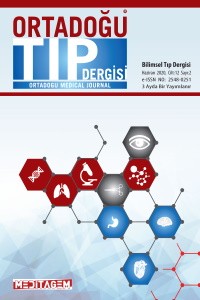Öz
SARS-CoV-2 veya COVID-19 olarak bilinen yeni koronavirüs, Çin’de Aralık 2019’daki ilk klinik vaka ile ortaya çıktı ve daha sonra çok hızlı bir şekilde küresel bir soruna dönüştü. İran, nüfusu 82531700 olan bir kalabalık Ortadoğu ülkesidir. 31.03.2020 tarihine kadar İran’daki vaka sayısı 44605’e ulaştı ve 2898 hasta hayatını kaybetti. Bu çalışmada, genel anlamda bulaşıcı hastalığa yakalanmış bireylerin P sayısının zamana göre değişim (yayılma) hızı; hastalığa yakalanmış olanların sayısı ile yakalanmamış olanların sayısının çarpımı ile orantılı olması bilgisinden yola çıkarak oluşturulan yeni bir modifiye özgün matematiksel modelleme üzerinden COVID-19 pandemisinin İran’daki gidişatının simüle edilmesi amaçlandı. Önlemler biraz artarsa, hastalığın ilerlemesi üzerine yansıması “üstsel” olacağı için, vaka sayısının 120 bine düşmesi ve ölümlerin 8 bin civarında olması bile mümkün görünmektedir. Modifiye matematiksel modelleme sonuçlarımıza göre, İran’daki pandeminin seyrini değiştirmek için etkili bir şekilde bireysel ve kamusal önlemler mutlaka acilen alınmalıdır. En etkili bireysel önlemler hijyene azami önem vermek, doğal ve sağlıklı beslenmek, hareketliliği ve egzersizi arttırmak ve sosyal izolasyona dikkat etmek olarak sıralanabilir.
Anahtar Kelimeler
COVID-19 matematiksel modelleme pandemi önlemler halk sağlığı
Kaynakça
- Soldati G, Smargiassi A, Inchingolo R, Buonsenso D, Perrone T, Briganti DF, et al. Proposal for international standardization of the use of lung ultrasound for COVID-19 patients; a simple, quantitative, reproducible method. J Ultrasound Med 2020. (doi: 10.1002/jum.15285).
- Hu TY, Frieman M, Wolfram J. Insights from nanomedicine into chloroquine efficacy against COVID-19. Nat Nanotechnol 2020. (doi: 10.1038/s41565-020-0674-9.
- Mousavi SH, Shah J, Giang HTN, Al-Ahdal TMA, Zahid SU, Temory F, et al. The first COVID-19 case in Afghanistan acquired from Iran. Lancet Infect Dis 2020. (doi: 10.1016/S1473-3099(20)30231-0).
- Coronavirus Infection Map. Available at: https://www.worldometers.info/coronavirus/country/iran/ (Accessed April 1, 2020).
- Lippi G, Plebani M. The critical role of laboratory medicine during coronavirus disease 2019 (COVID-19) and other viral outbreaks. Clin Chem Lab Med 2020. (doi: 10.1515/cclm-2020-0240).
- Edwards CH, Penney DE. Differential Equations and Boundary Value Problems: Computing and Modeling. 5th ed. Pearson Prentice Hall. USA. 2008.
- Cakir Z, Savas HB. A Mathematical Modelling Approach in the Spread of the Novel 2019 Coronavirus SARS-CoV-2 (COVID-19) Pandemic. Electron J Gen Med. 2020; 17(4): em205. (doi: 10.29333/ejgm/7861).
Öz
The novel coronavirus which is known as SARS-CoV-2 or COVID-19 emerged in China with the first clinical case in December 2019, and afterwards, it has turned into a global problem very fast. Iran is a crowder Middle Eastern country with a population of 82531700. Until 31.03.2020, the number of cases in Iran reached 44605, and 2898 patients lost their lives. This study aimed to simulate the progression of the COVID-19 pandemic in Iran with modified mathematical modelling established based on the information that the time-dependent change (spreading rate) in the number P of the individuals who has caught a contagious disease is proportional to the multiplication of the numbers of those who have caught the disease and those who have not. If the precautions are increased a little bit, as its reflection on the progression of the disease would be “exponential”, it seems possible for the number of cases to decrease down to around 120 thousand and for the deaths to be around 8 thousand or even lower. According to our modified mathematical modelling results, in order to change the course of the pandemic in Iran, effective individual and public precautions should definitely be taken urgently. The most effective individual precautions may be listed as paying maximal attention to hygiene, having a natural and healthy diet, increasing mobility and exercise and paying attention to social isolation.
Anahtar Kelimeler
COVID-19 mathematical modelling pandemic precautions public health
Kaynakça
- Soldati G, Smargiassi A, Inchingolo R, Buonsenso D, Perrone T, Briganti DF, et al. Proposal for international standardization of the use of lung ultrasound for COVID-19 patients; a simple, quantitative, reproducible method. J Ultrasound Med 2020. (doi: 10.1002/jum.15285).
- Hu TY, Frieman M, Wolfram J. Insights from nanomedicine into chloroquine efficacy against COVID-19. Nat Nanotechnol 2020. (doi: 10.1038/s41565-020-0674-9.
- Mousavi SH, Shah J, Giang HTN, Al-Ahdal TMA, Zahid SU, Temory F, et al. The first COVID-19 case in Afghanistan acquired from Iran. Lancet Infect Dis 2020. (doi: 10.1016/S1473-3099(20)30231-0).
- Coronavirus Infection Map. Available at: https://www.worldometers.info/coronavirus/country/iran/ (Accessed April 1, 2020).
- Lippi G, Plebani M. The critical role of laboratory medicine during coronavirus disease 2019 (COVID-19) and other viral outbreaks. Clin Chem Lab Med 2020. (doi: 10.1515/cclm-2020-0240).
- Edwards CH, Penney DE. Differential Equations and Boundary Value Problems: Computing and Modeling. 5th ed. Pearson Prentice Hall. USA. 2008.
- Cakir Z, Savas HB. A Mathematical Modelling Approach in the Spread of the Novel 2019 Coronavirus SARS-CoV-2 (COVID-19) Pandemic. Electron J Gen Med. 2020; 17(4): em205. (doi: 10.29333/ejgm/7861).
Ayrıntılar
| Birincil Dil | İngilizce |
|---|---|
| Konular | Sağlık Kurumları Yönetimi |
| Bölüm | Araştırma makaleleri |
| Yazarlar | |
| Yayımlanma Tarihi | 1 Haziran 2020 |
| Yayımlandığı Sayı | Yıl 2020 Cilt: 12 Sayı: 2 |
e-ISSN: 2548-0251
The content of this site is intended for health care professionals. All the published articles are distributed under the terms of
Creative Commons Attribution Licence,
which permits unrestricted use, distribution, and reproduction in any medium, provided the original work is properly cited.


